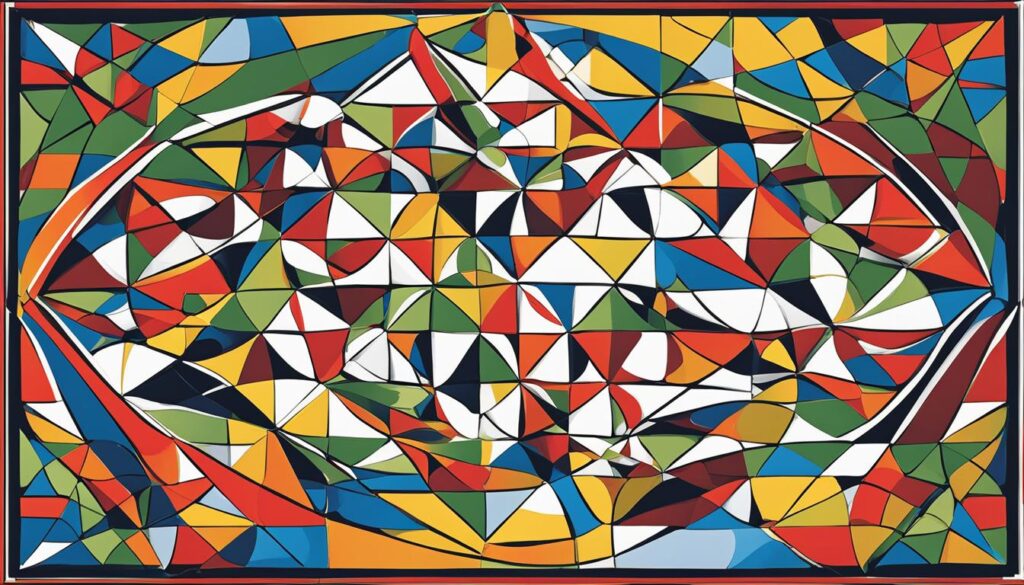Flatterland is an intellectual adventure that takes readers on a journey through mathematical concepts and multidimensional spaces. Written by Ian Stewart, the book is a continuation of Edwin A. Abbott’s “Flatland,” exploring its dynamic world in greater depth.
In “Flatterland,” readers follow the protagonist, Victoria Line, as she navigates through various dimensions and encounters groundbreaking mathematical theories. From curved spaces to challenging puzzles, the book presents complex topics in an engaging and accessible manner, providing readers with a fascinating glimpse into the realm of mathematical imagination.
Key Takeaways
- Ian Stewart’s “Flatterland” is a continuation of Edwin A. Abbott’s “Flatland,” exploring its world of two-dimensional beings and geometrical shapes.
- The book presents complex mathematical concepts in an accessible and engaging manner, with the protagonist, Victoria Line, on a journey through various dimensions.
- Readers will encounter fascinating topics such as curved spaces, challenging puzzles, and infinite possibilities, expanding their perception of mathematical imagination.
- “Flatterland” is a must-read for anyone interested in multidimensional spaces and the philosophical implications of embracing the infinite.
- Overall, Stewart’s book is an intellectual adventure that challenges readers to expand their understanding of mathematics and reality itself.
Understanding Flatland
Flatland is a unique two-dimensional world created by Edwin A. Abbott in his novel “Flatland: A Romance of Many Dimensions.” In this geometric realm, everything exists on a two-dimensional plane, and the inhabitants are two-dimensional beings, including geometric shapes such as squares, circles, and triangles.
The concept of Flatland brings forth limitations and possibilities. Living entities in Flatland can only see and interact with objects on their own plane, leading to a narrow perception of the world around them. However, their unique environment allows for exploration and understanding of geometry in a way that is not possible in our three-dimensional world.
The inhabitants of Flatland have their unique characteristics. For instance, their shapes determine their social class, with regular polygons being the most highly ranked. It is only through the protagonist’s journey through different dimensions that the reader uncovers the peculiarities of life in Flatland, making it an exciting adventure.
The Journey Begins
Join the protagonist on their quest through Flatterland, a fascinating mathematical world full of wonder and adventure. As the journey starts, the protagonist boards the Victoria Line, accompanied by a knowledgeable guide. They set off into the unknown, ready to explore the mysteries of multidimensional space.
The guide leads the protagonist through various dimensions and demonstrates the intricacies of mathematical concepts along the way. As they venture further, the protagonist encounters strange and exciting characters, each embodying a specific mathematical concept and adding depth to the story.
“The Victoria Line train rumbled underfoot as we began our journey, with the guide’s encouraging words and vivid, mathematical descriptions inspiring us onwards.”
Together, the protagonist and guide navigate through the fascinating world of Flatterland, unlocking the secrets of multidimensional space and gaining new insights into the mysteries of the universe.
Exploring Mathematical Concepts
In “Flatterland,” readers are introduced to various mathematical concepts that are essential to the storyline. These concepts span across different fields, including geometry, topology, and calculus. Understanding these concepts is crucial to comprehending the underlying themes and ideas shaping the narrative.
Geometry, the mathematical study of shapes and their properties, is central to our understanding of Flatterland. Throughout the book, readers encounter various geometrical shapes that play a significant role in the storyline. From triangles to circles and cones, each shape has its unique symbolic meaning and relevance.
Topology, on the other hand, focuses on the study of spaces and their properties. In Flatterland, topology plays a crucial role in helping readers understand the concept of dimensions and the complexity of multidimensional spaces. From the Victoria Line to the hidden realms, topology provides a lens for exploring the intricate relationships between spaces and dimensions.
Calculus, the branch of mathematics that deals with the study of continuous change, is also critical to Flatterland’s narrative. Calculus plays a role in understanding the geometry of curved surfaces and the complexities of dimensional shifts. Through calculus, readers can gain insight into the intricacies of space and its limitless possibilities.
Dimensional Shifts
In “Flatterland,” the protagonist embarks on a journey that takes them beyond the confines of Flatland into the realm of multidimensional space. Through shifting dimensions, the protagonist gains a thorough understanding of the intricacies of space and how it interacts with geometrical shapes and mathematical concepts.
As Ian Stewart puts it, “We think in Flatland. We live in Flatland. But we are not confined to Flatland.” The protagonist’s journey is a testament to the boundless possibilities that exist beyond our limited perceptions of space and reality.

“Where your mind goes, you go,” said the guide, who accompanies the protagonist on their journey. “Think beyond what you see, and you will discover a world beyond your wildest imagination.”
The journey through Flatterland highlights the importance of embracing a multidimensional perspective on space and reality. It challenges us to expand our understanding and to think beyond the confines of two-dimensional thinking. By embracing the concept of dimensional shifts, we open ourselves up to a world of limitless possibilities and unthinkable discoveries.
Meeting Colorful Characters
As the protagonist journeys through Flatterland, they encounter a cast of fascinating characters that embody various mathematical concepts. Some of these characters include:
| Character | Personality | Mathematical Concept Embodied |
|---|---|---|
| A. Square | Curious and skeptical | Two-dimensional geometry |
| Circles | Haughty and arrogant | Higher dimensions and topology |
| Spherius | Enthusiastic and childlike | Non-Euclidean geometry and warped spaces |
These colorful characters add depth to the narrative and help the reader gain a deeper understanding of complex mathematical concepts, while also serving as a reminder of how personality traits can influence an individual’s approach to problem-solving. In this way, “Flatterland” showcases the interconnectedness between characters, personalities, and mathematical concepts.
Unlocking Hidden Realms
As our protagonist navigates through Flatterland, they encounter hidden realms beyond our known dimensions. Parallel universes and alternate dimensions exist, each with its unique characteristics and mathematical concepts. These realms are not easily accessible, and only a select few possess the knowledge and ability to traverse these dimensions.
Through the protagonist’s journey, we gain a deeper understanding of these hidden realms and the impact they hold on the storyline. The possibilities presented by these dimensions are limitless, showcasing the boundless potential of mathematical imagination and expanding our understanding of the universe.
The exploration of hidden realms unveils a new level of depth to the novel’s narrative and reinforces the significance of mathematical concepts in shaping alternate realities. The implications of these alternate dimensions add a layer of mystery and intrigue to the plot, creating a sense of awe and wonder as we explore the possibilities of the unknown.
Navigating Curved Spaces
Flatterland presents the intriguing concept of curved spaces, which plays a vital role in understanding multidimensional spaces beyond Flatland. The book introduces non-Euclidean geometry, a branch of mathematics that deals with curved surfaces, presenting an alternative to Euclidean geometry that is limited to flat surfaces and straight lines only.
Warped surfaces create fascinating opportunities for exploration, expanding the traditional notion of what constitutes space. They challenge the conventional understanding of geometry and present new possibilities for understanding space beyond the familiar limits we have grown accustomed to.
Flatterland’s journey through curved spaces invites readers to think outside the box, challenge their preconceived notions of space and explore new avenues of mathematical inquiry.
Challenging Mathematical Puzzles
In Flatterland, readers encounter a myriad of mathematical puzzles and riddles that challenge their problem-solving skills and expand their understanding of mathematical concepts. These puzzles range from visual conundrums to complex equations and require readers to approach them with a creative and analytical mindset, developing their reasoning and analytical skills.
One example of such a puzzle is presented in the story’s opening, where the protagonist encounters a strange creature that speaks in riddles. The creature asks, “What do you call a shape that makes the shortest possible path between two points?” The answer, which the protagonist must discover, is a geodesic.
Another example of an engaging mathematical challenge in Flatterland involves the use of topology and knot theory. The protagonist faces a perplexing situation where they are asked to untangle a series of knots from which there is seemingly no escape. The solution requires understanding the fundamental principles of knot theory, highlighting the significance of mathematical concepts in creative problem-solving.
“The beauty of mathematical puzzles is that they require both creativity and logic, both intuition and reasoning. They challenge us to think outside the box and develop new ways of approaching complex problems. Flatterland presents readers with a delightful array of these kinds of challenges, expanding both their mathematical comprehension and their problem-solving skills.”

The puzzles and riddles presented in Flatterland serve not only as a means of entertainment but also as a way to develop vital skills for mathematical comprehension. They challenge readers to expand their imagination and approach complex problems with creative solutions, imparting skills that have practical applications beyond the pages of the book.
Discovering New Perspectives
As the protagonist journeys through Flatterland, their mathematical understanding is transformed, offering new perspectives and insights that reshape their perception of reality. Through encounters with fascinating mathematical concepts and multidimensional spaces, the protagonist gains a heightened awareness of the possibilities and limitations of their world.
One significant perspective shift occurs with the introduction of non-Euclidean geometry and curved spaces. The protagonist learns to navigate these new dimensions, expanding their understanding of space and challenging their preconceptions of what is possible. Additionally, encounters with colorful characters further broaden their mathematical horizons, providing a deeper appreciation for the intricacies and applications of mathematical concepts.
These experiences offer valuable insights into the power of mathematical understanding in shaping our perceptions and broadening our perspectives. Through Flatterland, readers gain an appreciation for the importance of pushing the boundaries of mathematical imagination and exploring limitless possibilities.
“In mathematics, the art of proposing a question must be held of higher value than solving it.” – Georg Cantor
Cantor’s quote highlights the importance of embracing curiosity and challenging ourselves to explore new possibilities, both in mathematics and in life. By adopting this mindset, we can continue to discover new perspectives and insights, leading us to innovative and creative solutions to complex problems.
The Power of Mathematical Imagination
In “Flatterland,” mathematical imagination, creativity, and innovative thinking are essential elements for expanding one’s understanding of mathematical concepts. Ian Stewart’s captivating tale explores the importance of unconventional approaches for comprehending complex theories.
Mathematical imagination enables individuals to visualize abstract concepts and make connections between seemingly disparate ideas. Creative thinking allows for the exploration of novel solutions and the resolution of challenging puzzles.
Similarly, innovative thinking facilitates the discovery of new perspectives and the development of groundbreaking concepts. By embracing these imaginative techniques, individuals can push the boundaries of traditional mathematical understanding and uncover endless possibilities.
“Flatterland” illustrates that mathematical imagination facilitates extraordinary encounters, including multidimensional beings and hidden realms. By cultivating a sense of curiosity and embracing novelty, individuals may achieve a deeper understanding of the underlying principles of mathematics, leading to unparalleled insights.
“Without mathematics, there’s nothing you can do. Everything around you is mathematics. Everything around you is numbers.” – Shakuntala Devi
As exemplified in “Flatterland,” mathematics is a critical tool for understanding the world around us. By harnessing the power of mathematical imagination, individuals may unlock uncharted territories and discover limitless possibilities. Through creative and innovative thinking, insights into mathematical concepts can be achieved, transcending traditional limitations and pushing boundaries.
Embracing the Infinite
Flatterland challenges our perceptions of reality with its exploration of multidimensional spaces and the philosophical implications of infinity. The concept of infinity is a recurring theme throughout the book, imbuing it with a sense of boundlessness and limitless possibilities.
As the protagonist navigates through different dimensions, they encounter the infinite, expanding their understanding of space beyond the confines of Flatland. The implications of embracing the infinite within mathematical realms are profound, highlighting the interconnectedness between seemingly disparate mathematical fields.
“Infinity is the hallmark of imaginative mathematical thinking, and Flatterland embodies the power of our capacity for abstract thought.”
The application of mathematical imagination and innovative thinking within the context of infinity in Flatterland is a testament to the vast potential of mathematics in shaping our understanding of the world. By embracing the infinite, we can unlock hidden realms and explore new perspectives, revealing the boundless possibilities of mathematical exploration.
Conclusion
In summary, Flatterland: Like Flatland, Only More So by Ian Stewart is an imaginative journey through mathematical concepts and dimensions. Stewart’s thought-provoking narrative engages readers and expands their understanding of geometry, topology, and calculus. The protagonist’s encounters with colorful characters and hidden realms provide insight into the boundless possibilities of mathematical imagination.
Throughout the book, Stewart challenges readers with mathematical puzzles and riddles that develop problem-solving skills and expand comprehension. The concept of infinity is explored in-depth, unlocking philosophical implications and limitless possibilities.
Overall, Flatterland provides a unique and engaging perspective on mathematics and its role in shaping our understanding of the world. Ian Stewart’s masterful storytelling and accessible writing style make this book an excellent resource for both educators and students.
If you’re looking to expand your mathematical horizons and explore parallel universes and multidimensional spaces, Flatterland is a must-read. Ian Stewart’s work remains an insightful and thought-provoking contribution to the mathematical world, sure to inspire readers for years to come.
So, if you haven’t already, be sure to add Flatterland to your reading list and embark on a journey like no other.
Keywords: book summary, Flatterland, Ian Stewart
FAQ
What is “Flatterland: Like Flatland, Only More So” about?
“Flatterland: Like Flatland, Only More So” is a book written by Ian Stewart that explores the similarities between “Flatterland” and its predecessor “Flatland.” It provides a summary of the key insights and concepts presented in the book.
What is Flatland?
Flatland is a two-dimensional world created by Edwin A. Abbott. It is a geometric realm with limitations and unique characteristics, inhabited by two-dimensional beings.
What is the protagonist’s journey in Flatterland?
The protagonist embarks on a journey through Flatterland, starting with the Victoria Line. They explore various dimensions and encounter fascinating mathematical concepts, guided by their experiences.
What mathematical concepts are explored in “Flatterland”?
“Flatterland” explores various mathematical concepts, including geometry, topology, and calculus. These concepts are discussed in relation to the storyline and their relevance to understanding the multidimensional world.
What are dimensional shifts in Flatterland?
Dimensional shifts in Flatterland refer to the protagonist’s navigation through different dimensions. They expand their understanding of space beyond Flatland and explore the complexities of multidimensional realms.
Who are the colorful characters in Flatterland?
Flatterland introduces a range of colorful characters that the protagonist encounters on their journey. These characters embody various mathematical concepts and add depth to the narrative.
Are there hidden realms and alternate dimensions in Flatterland?
Yes, Flatterland unveils hidden realms and parallel universes existing within its multidimensional world. These alternate dimensions have significant implications for the storyline and the protagonist’s journey.
What are curved spaces in Flatterland?
Curved spaces in Flatterland refer to non-Euclidean geometry and warped surfaces. They play a vital role in understanding the intricacies of multidimensional spaces and expanding the protagonist’s perception of reality.
Are there mathematical puzzles and challenges in Flatterland?
Yes, Flatterland presents various mathematical puzzles and challenges throughout the narrative. These puzzles serve as opportunities for readers to develop problem-solving skills and deepen their mathematical comprehension.
How does Flatterland transform the protagonist’s perspective?
The journey through Flatterland broadens the protagonist’s perspective and reshapes their perception of reality. They gain new insights and a deeper understanding of mathematical concepts and their applications.
What role does mathematical imagination play in Flatterland?
Mathematical imagination plays a significant role in Flatterland, fostering creativity and innovative thinking. It pushes the boundaries of mathematical concepts and expands the realm of possibilities.
How does Flatterland explore the concept of infinity?
Flatterland delves into the concept of infinity and its philosophical implications. It explores the boundless possibilities that come with embracing infinity within the mathematical realm.
What can readers expect from Ian Stewart’s Flatterland?
Readers can expect a comprehensive exploration of mathematical concepts, dimensional journeys, and philosophical implications. The book provides a unique perspective on understanding the multidimensional world of Flatterland.
What are the key insights and takeaways from Flatterland?
Flatterland offers insights into mathematical concepts, the power of imagination, and the significance of embracing new perspectives. It encourages readers to explore the boundless possibilities within the realm of mathematics.



